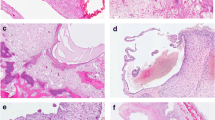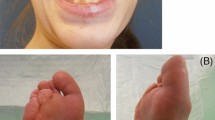Abstract
Objective
USP6 rearrangements with several partner genes have been identified recently in primary but not in secondary aneurysmal bone cysts (ABCs). Several lesions show histologic features that may overlap with ABC, including myositis ossificans (MO), brown tumor, and cherubism. The objective of this study was to assess whether these lesions harbored USP6 rearrangements.
Materials and methods
Twelve patients with classic radiologic and histologic features of MO, 6 with brown tumors, and 5 with cherubism diagnosed at our institution were studied for the presence of USP6 rearrangements using fluorescence in situ hybridization with probes flanking the USP6 locus on chromosome 17p13. In addition, conventional cytogenetic analysis was performed in 2 patients with cherubism.
Results
USP6 rearrangements were identified in 2 patients with radiologic and histologic features consistent with MO. None of the patients with brown tumor or cherubism demonstrated USP6 rearrangements. Cytogenetic analysis of the cherubism patients demonstrated normal karyotypes.
Conclusion
These findings indicate that a subset of cases with apparent classic histologic and imaging features of MO are rather better classified as being soft-tissue ABC with clonal USP6 rearrangements. In contrast, no USP6 rearrangements were found in patients with cherubism or brown tumor, supporting the prevailing view that these lesions are distinct biologic entities.



Similar content being viewed by others
References
Rosenberg AE, Nielsen GP, Fletcher JA. Aneurysmal bone cyst. In: Fletcher CDM, Unni KK, Mertens F, editors. World Health Organization classification of tumours: pathology and genetics of tumours of soft tissue and bone. Lyon: IARC Press; 2002. p. 338–339.
Vergel De Dios AM, Bond JR, Shives TC, McLeod RA, Unni KK. Aneurysmal bone cyst: a clinicopathologic study of 238 cases. Cancer 1992; 69: 2921–2931.
Panoutsakopoulos G, Pandis N, Kyriazoglou I, Gustafson P, Mertens F, Mandahl N. Recurrent t(16;17)(q22;p13) in aneurysmal bone cysts. Genes Chromosomes Cancer 1999; 26: 265–266.
Oliveira AM, Hsi BL, Weremowicz S, Rosenberg AE, Dal Cin P, Joseph N, et al. USP6 (Tre2) fusion oncogenes in aneurysmal bone cyst. Cancer Res 2004; 64: 1920–1923.
Althof PA, Ohmori K, Zhou M, Bailey JM, Bridge RS, Nelson M, et al. Cytogenetic and molecular cytogenetic findings in 43 aneurysmal bone cysts: aberrations of 17p mapped to 17p13.2 by fluorescence in situ hybridization. Mod Pathol 2004; 17: 518–525.
Winnepenninckx V, Debiec-Rychter M, Jorissen M, Bogaerts S, Sciot R. Aneurysmal bone cyst of the nose with 17p13 involvement. Virchows Arch 2001; 439: 636–639.
Wyatt-Ashmead J, Bao L, Eilert RE, Gibbs P, Glancy G, McGavran L. Primary aneurysmal bone cysts: 16q22 and/or 17p13 chromosome abnormalities. Pediatr Dev Pathol 2001; 4: 418–419.
Oliveira AM, Perez-Atayde AR, Dal Cin P, Gebhardt MC, Chen CJ, Neff JR, et al. Aneurysmal bone cyst variant translocations upregulate USP6 transcription by promoter swapping with the ZNF9, COL1A1, TRAP150, and OMD genes. Oncogene 2005; 24:3419–3426.
Dal Cin P, Kozakewich HP, Goumnerova L, Mankin HJ, Rosenberg AE, Fletcher JA. Variant translocations involving 16q22 and 17p13 in solid variant and extraosseous forms of aneurysmal bone cyst. Genes Chromosomes Cancer 2000; 28: 233–234.
Herens C, Thiry A, Dresse MF, Born J, Flagothier C, Vanstraelen G, et al. Translocation (16;17)(q22;p13) is a recurrent anomaly of aneurysmal bone cysts. Cancer Genet Cytogenet 2001; 127: 83–84.
Oliveira AM, Perez-Atayde AR, Inwards CY, Medeiros F, Derr V, Hsi BL, et al. USP6 and CDH11 oncogenes identify the neoplastic cell in primary aneurysmal bone cysts and are absent in so-called secondary aneurysmal bone cysts. Am J Pathol 2004; 165: 1773–1780.
Rosenberg AE. Myositis ossificans and fibroosseous pseudotumors of digits. In: Fletcher CDM, Unni KK, Mertens F, editors. World Health Organization classification of tumours: pathology and genetics of tumours of soft tissue and bone. Lyon: IARC; 2002. p. 52–54.
Unni KK, Inwards CY, Bridge JA, Kindblom L-G, Wold LE. Tumours of the bones and joints. 4th series, fascicle 2. Washington, DC: American Registry of Pathology; 2005. p. 324–329, 370, 371.
Fletcher JA, Kozakewich HP, Hoffer FA, Lage JM, Weidner N, Tepper R, et al. Diagnostic relevance of clonal cytogenetic aberrations in malignant soft-tissue tumors. N Engl J Med 1991; 324: 436–442.
Kimmel DW, O’Fallon JR, Scheithauer BW, Kelly PJ, Dewald GW, Jenkins RB. Prognostic value of cytogenetic analysis in human cerebral astrocytomas. Ann Neurol 1992; 31: 534–542.
Schaffer LG, Tommerup N, editors. ISCN 2005: an international system for human cytogenetic nomenclature: recommendations of the International Standing Committee on Human Cytogenetic Nomenclature. Basel: Karger; 2005.
Amir G, Mogle P, Sucher E. Case report 729: myositis ossificans and aneurysmal bone cyst. Skeletal Radiol 1992; 21: 257–259.
Kransdorf MJ, Meis JM, Jelinek JS. Myositis ossificans: MR appearance with radiologic-pathologic correlation. AJR Am J Roentgenol 1991; 157: 1243–1248.
Siegel MJ. Magnetic resonance imaging of musculoskeletal soft tissue masses. Radiol Clin North Am 2001; 39: 701–720.
Nielsen GP, Fletcher CD, Smith MA, Rybak L, Rosenberg AE. Soft tissue aneurysmal bone cyst: a clinicopathologic study of five cases. Am J Surg Pathol 2002; 26: 64–69.
Salm R, Sissons HA. Giant-cell tumours of soft tissues. J Pathol 1972; 107: 27–39.
Ajilogba KA, Kaur H, Duncan R, McFarlane JH, Watt AJ. Extraosseous aneurysmal bone cyst in a 12-year-old girl. Pediatr Radiol 2005; 35: 1240–1242.
Lopez-Barea F, Rodriguez-Peralto JL, Burgos-Lizaldez E, Alvarez-Linera J, Sanchez-Herrera S. Primary aneurysmal cyst of soft tissue: report of a case with ultrastructural and MRI studies. Virchows Arch 1996; 428: 125–129.
Petrik PK, Findlay JM, Sherlock RA. Aneurysmal cyst, bone type, primary in an artery. Am J Surg Pathol 1993; 17: 1062–1066.
Rodriguez-Peralto JL, Lopez-Barea F, Sanchez-Herrera S, Atienza M. Primary aneurysmal cyst of soft tissues (extraosseous aneurysmal cyst). Am J Surg Pathol 1994; 18: 632–636.
Shannon P, Bedard Y, Bell R, Kandel R. Aneurysmal cyst of soft tissue: report of a case with serial magnetic resonance imaging and biopsy. Hum Pathol 1997; 28: 255–257.
Wang XL, Gielen JL, Salgado R, Delrue F, De Schepper AM. Soft tissue aneurysmal bone cyst. Skeletal Radiol 2004; 33: 477–480.
Miah SM, Hatani T, Qu X, Yamamura H, Sada K. Point mutations of 3BP2 identified in human-inherited disease cherubism result in the loss of function. Genes Cells 2004; 9: 993–1004.
Ueki Y, Tiziani V, Santanna C, Fukai N, Maulik C, Garfinkle J, et al. Mutations in the gene encoding c-Abl-binding protein SH3BP2 cause cherubism. Nat Genet 2001; 28: 125–126.
Imai Y, Kanno K, Moriya T, Kayano S, Seino H, Matsubara Y, et al. A missense mutation in the SH3BP2 gene on chromosome 4p16.3 found in a case of nonfamilial cherubism. Cleft Palate Craniofac J 2003; 40: 632–638.
Lo B, Faiyaz-Ul-Haque M, Kennedy S, Aviv R, Tsui L-C, Teebi AS. Novel mutation in the gene encoding c-Abl-binding protein SH3BP2 causes cherubism. Am J Med Genet 2003; 121A: 37–40.
Ren R, Mayer BJ, Cicchetti P, Baltimore D. Identification of a ten-amino acid proline-rich SH3 binding site. Science 1993; 259:1157–1161.
Deckert M, Tartare-Deckert S, Hernandez J, Rottapel R, Altman A. Adaptor function for the Syk kinases-interacting protein 3BP2 in IL-2 gene activation. Immunity 1998; 9: 595–605.
Acknowledgment
Andre M. Oliveira is supported by the Fraternal Order of Eagles Foundation Award 237 and the Mayo Clinic CR20 Award 14546.
Author information
Authors and Affiliations
Corresponding author
Additional information
The experiments described in this report are in compliance with current laws of the United States.
This study was approved by the Mayo Clinic Institutional Review Board.
Rights and permissions
About this article
Cite this article
Sukov, W.R., Franco, M.F., Erickson-Johnson, M. et al. Frequency of USP6 rearrangements in myositis ossificans, brown tumor, and cherubism: molecular cytogenetic evidence that a subset of “myositis ossificans-like lesions” are the early phases in the formation of soft-tissue aneurysmal bone cyst. Skeletal Radiol 37, 321–327 (2008). https://doi.org/10.1007/s00256-007-0442-z
Received:
Revised:
Accepted:
Published:
Issue Date:
DOI: https://doi.org/10.1007/s00256-007-0442-z




